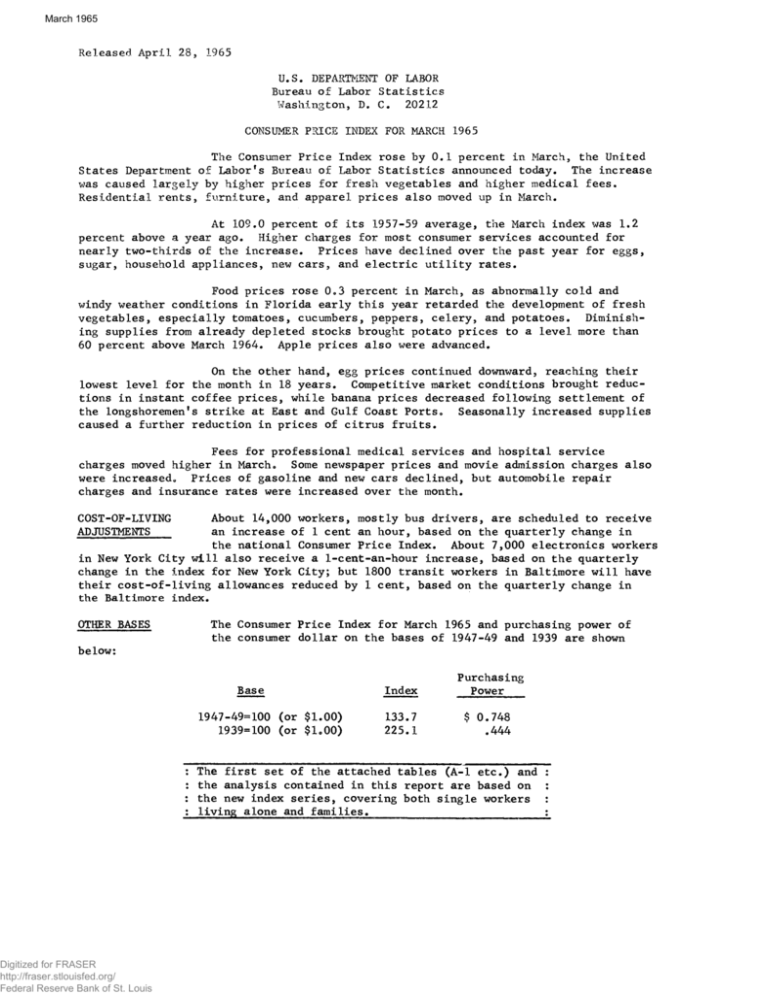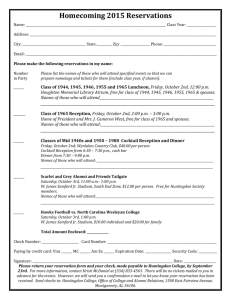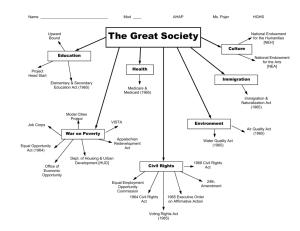Consumer Price Index for 1965 - Fraser
advertisement

March 1965 Released April 28, 1965 U.S. DEPARTMENT OF LABOR Bureau of Labor Statistics Washington, D. C . 20212 CONSUMER PRICE INDEX FOR MARCH 1965 The Consumer Price Index rose by 0.1 percent in March, the United States Department of Labor's Bureau of Labor Statistics announced today. The increase was caused largely by higher prices for fresh vegetables and higher medical fees. Residential rents, furniture, and apparel prices also moved up in March. At 109.0 percent of its 1957-59 average, the March index was 1.2 percent above a year ago. Higher charges for most consumer services accounted for nearly two-thirds of the increase. Prices have declined over the past year for eggs, sugar, household appliances, new cars, and electric utility rates. Food prices rose 0,3 percent in March, as abnormally cold and windy weather conditions in Florida early this year retarded the development of fresh vegetables, especially tomatoes, cucumbers, peppers, celery, and potatoes. Diminishing supplies from already depleted stocks brought potato prices to a level more than 60 percent above March 1964. Apple prices also were advanced. On the other hand, egg prices continued downward, reaching their lowest level for the month in 18 years. Competitive market conditions brought reductions in instant coffee prices, while banana prices decreased following settlement of the longshoremen's strike at East and Gulf Coast Ports« Seasonally increased supplies caused a further reduction in prices of citrus fruits. Fees for professional medical services and hospital service charges moved higher in March. Some newspaper prices and movie admission charges also were increased. Prices of gasoline and new cars declined, but automobile repair charges and insurance rates were increased over the month. COST-OF-LIVING ADJUSTMENTS About 14,000 workers, mostly bus drivers, are scheduled to receive an increase of 1 cent an hour, based on the quarterly change in the national Consumer Price Index. About 7,000 electronics workers in New York City will also receive a 1-cent-an-hour increase, based on the quarterly change in the index for New York City; but 1800 transit workers in Baltimore will have their cost-of-living allowances reduced by 1 cent, based on the quarterly change in the Baltimore index. OTHER BASES The Consumer Price Index for March 1965 and purchasing power of the consumer dollar on the bases of 1947-49 and 1939 are shown below: Digitized for FRASER http://fraser.stlouisfed.org/ Federal Reserve Bank of St. Louis Base 1947-49=100 (or $1.00) 1939=100 (or $1,00) : : : : Index Purchasing Power 133.7 225.1 $ 0.748 .444 The first set of the attached tables (A-l etc.) and the analysis contained in this report are based on the new index series, covering both single workers living alone and families* April 1965 Released May 27, 1965 U.S. DEPARTMENT OF LABOR Bureau of Labor Statistics Washington, D. C. 20212 CONSUMER PRICE INDEX FOR APRIL 1965 The Consumer Price Index advanced by 0.3 percent in April as prices of nearly all consumer goods and services rose, the United States Department of Labor's Bureau of Labor Statistics announced today. Higher prices for gasoline, fresh fruits and vegetables, and consumer services were the most important factors in the increase. The April index at 109.3 percent of its 1957-59 average, was 1.4 percent above its level of a year ago, mainly as the result of higher prices for consumer services and nondurable commodities. Food prices rose 0.4 percent in April, led by higher prices for fresh fruits. As usual, strawberries were substantially higher priced as they returned to market than at the end of last year's season. Apples also advanced but oranges were lower. Price increases were also reported for green peppers, potatoes, and cucumbers, which were in short supply in April. A 6.1 percent upturn in egg prices, reversing a 6-months downturn, reflected increased demand prior to Easter. Meat prices averaged 0.2 percent higher in response to a reduction in supplies. A 0.5 percent decline in dairy food prices was the result of seasonally increased supplies of fresh milk. Higher average gasoline prices were observed in most cities, reflecting lessened competitive pressures. Used car prices were lower as record new car sales resulted in a high volume of trade-ins on dealers' lots. The introduction of new spring lines in some areas at higher prices than at the end of last season caused a 0.3 percent rise in apparel prices. Higher costs of college tuition, professional medical services, and household services were chiefly responsible for the increase in consumer service prices. COST-OF-LIVING ADJUSTMENTS Based on a review of the national Consumer Price Index for the quarter ending April, about 900,000 workers will receive cost-ofliving increases of 1 cent an hour. Of these, 750,000 are employed by automobile and automotive parts manufacturers, 70,000 by aerospace firms, and 50,000 in the farm and construction equipment industries. Approximately 30,000 workers in other industries will receive the same increase. In addition, about 11,500 transit workers will receive increases of 1% cents an hour, based on the quarterly change in the index for the Chicago area. OTHER BASES The Consumer Price Index for April 1965 and purchasing power of the consumer dollar on the bases of 1947-49 and 1939 are shown below: Digitized for FRASER http://fraser.stlouisfed.org/ Federal Reserve Bank of St. Louis : : : : Base Index Purchasing Power 1947-49=100 (or $1.00) 1939=100 (or $1.00) 134.1 225.7 $ 0.746 .443 The first set of the attached tables (A-l etc.) and the analysis contained in this report are based on the new index series, covering both single workers living alone and families. May 1965 Released June 30 9 1965 U.S. DEPARTMENT OF LABOR Bureau of Labor Statistics Washington, D. C. 20212 CONSUMER PRICE INDEX FOR MAY 1965 Consumer prices advanced by 0.3 percent in May, the United States Department of Labor's Bureau of Labor Statistics announced today. Higher prices for meats, fresh vegetables, apparel, and gasoline, were primarily responsible for the increase. Prices of most consumer services also rose during the month. The May Consumer Price Index, at 109.6 (1957-59-100), was 1.7 percent above May of last year. Increased charges for services and higher food costs were largely responsible for the advance from a year ago. An increase of 0.6 percent in average food prices during the month was caused primarily by sharply higher prices for fresh vegetables, especially potatoes, lettuce, cabbage, and tomatoes, which were in short supply as a result of unfavorable weather. Cucumber prices dropped substantially, however, as supplies increased. Rising demand and short supplies pushed up prices of beef, veal, pork, and lamb. On the other hand, prices of frying chickens, milk, eggs, coffee, and bread were lower. Transportation costs rose 0.4 percent as gasoline prices increased in response to lessened competitive pressures. Used car prices advanced seasonally, but new car prices declined. Car owners also paid more for insurance premiums in some areas. The return of women's and girls' summer apparel items to the market at higher levels than last year's end-of-season prices was the main reason for the 0.5 percent rise in the apparel index. Prices for men's clothing also advanced, reflecting returns to regular levels after special sales. Cigarette prices continued to rise during May and services associated with professional medical care and personal care also cost more. Housing costs did not change on the average, as lower prices for most durable housefurnishings and lower mortgage interest rates combined to offset rising costs of housekeeping services, maintenance and repairs, and property taxes. COST-OF-LIVING ADJUSTMENTS About 183,000 workers will receive increases in their cost-ofliving allowances based on the national Consumer Price Index for May, as follows: 2 cents an hour for 101,000 workers, including 85,000 in meatpacking and 8,000 in aerospace; 1 cent an hour for 82,000, including 75,000 in aerospace industries. An additional 11,300 workers will receive increases based on city indexes: 2 cents an hour for 3,000 transit workers in Washington, D. C.; 4 cents an hour for 4,300 workers in food processing in Battle Creek, Michigan, based on the Consumer Price Index for Detroit; and 9 cents an hour for more than 4,000 drug 8tore clerks in the Los Angeles-long Beach area. OTHER BASES Digitized for FRASER http://fraser.stlouisfed.org/ Federal Reserve Bank of St. Louis The Consumer Price Index for May 1965 and purchasing power of the consumer dollar on the bases of 1947-49 and 1939 are shown below: Base 1947-49"® 100 (or $1.00) 1939-100 (or $1.00) Index Purchasing Power 134.5 226.3 $ 0.743 .442 June 1965 Released July 29, 1965 U.S. DEPARTMENT OF LABOR Bureau of Labor Statistics Washington, D. C. 20212 CONSUMER PRICE INDEX FOR JUNE 1965 The Consumer Price Index rose by 0.5 percent in June, to 110.1 percent of its 1957-59 average, the United States Department of Labor's Bureau of Labor Statistics announced today. Sharply higher prices for meats which were in short supply and for several fresh fruits and vegetables whose production was curtailed by weather were responsible for all but a small part of the May-to-June increase. Prices of new cars and household durables were lower in June, partly as a result of the reduction in Federal excise taxes. The index, which has increased between May and June in every year since 1951, was 1.9 percent above its level of a year ago. Increased prices for nondurable commodities (food, apparel, and gasoline) were responsible for about 60 percent of the over-the-year increase. Higher prices for consumer services caused the remainder of the rise. New cars, citrus fruits, sugar, and coffee were among the items whose prices were lower than in June 1964. Meats and poultry, which led the June rise in food prices, increased more than 6% percent. Reduced supplies caused by lower marketings of livestock and a continued strong consumer demand for meats were responsible for the advance. In addition, unfavorable weather conditions continued to influence prices of some fresh vegetables. Potatoes, which were in short supply because of the drought which reduced last year's crop, went up another 10 percent in price. Adverse weather conditions caused a temporary shortage of lettuce in June and an increase in lettuce prices for a brief period. On the other hand, prices dropped for tomatoes, green peppers, and cucumbers as seasonally increasing supplies reached the market. Watermelons were higher in price as they entered the market for the first time this year. The recent rise in food prices, especially for meats, showed up in higher restaurant meal prices in June. Prices of consumer durable goods declined 0.3 percent on the average, as new car prices showed the combined effects of rising concessions near the end of the model year and the excise tax reduction. Declines were also noted for household durables, some durable recreational goods, and appliances, but used car prices increased. Household services, especially mortgage interest, property taxes, and insurance continued to gain, as did costs of medical care services. Increasing State excise taxes and higher prices for some cigarettes caused tobacco products to average 0.8 percent more in June. Gasoline and motor oil prices also continued to advance. COST-OF-LIVING ADJUSTMENTS About 28,000 workers should receive cost-of-living increases ranging from 1 to 3 cents an hour, based on the quarterly change in the national Consumer Price Index for June. They are as follows: 1 cent an hour for 12,000 workers, including 11,000 employees of interstate bus companies; 2 cents an hour for 3,500 workers; and 3 cents an hour for 12,500, including 5,000 transit workers. In addition, about 8,000 workers will receive increases ranging from 2 to 5.7 cents an hour, based on quarterly reviews of city indexes: 2 cents an hour for 4,000 instrument workers in the New York City Area; 4.5 cents an hour for 1,800 transit workers in Baltimore; and 5.7 cents an hour ($2.00 for a 35-hour week) for 2,000 lithographers in San Francisco. Digitized for FRASER http://fraser.stlouisfed.org/ Federal Reserve Bank of St. Louis June 1965 2 OTHER BASES The Consumer Price Index for June 1965 and purchasing power of the consumer dollar on the bases of 1947-49 and 1939 are shown below: Digitized for FRASER http://fraser.stlouisfed.org/ Federal Reserve Bank of St. Louis Base 1947-49=100 (or $1.00) 1939=100 (or $1.00) Index Purchasing Power 135.1 227.4 $ 0.740 .440 :The first set of the attached tables (A-l etc.) and the :analysis contained in this report are based on the new :index series, covering both single workers living alone :and families. July 1965 Released August 27, 1965 U.So DEPARTMENT OF LABOR Bureau of Labor Statistics Washington, Do C. 20212 CONSUMER PRICE INDEX FOR JULY 1965 The Consumer Price Index rose by 0.1 percent in July, the United States Department of Labor's Bureau of Labor Statistics announced today. Higher meat prices and increased homeownership costs and rates for automobile insurance were primarily responsible for the increase. Prices of eggs, potatoes, and cigarettes also rose over the month. These increases were offset to a large extent by price declines for items included in the "first round1' of Federal excise tax reductions and by lower apparel prices. The July all-items index, at 110.2 (1957-59=100), was 1.8 percent above the July 1964 level. Increased costs of most consumer services and higher prices for selected foods were the principal causes of the rise. Meats and potatoes have advanced to record highs since July 1964. However, prices of some food items have shown a sharp decline over the year. These include orange juice concentrate, instant coffee, and fresh fruits. The increase of 0.7 percent in average food prices during the month was caused primarily by sharply higher prices of pork products, especially pork chops and bacon due to seasonally reduced supplies. Average prices of beef and veal moved up 1.2 percent, as demand increased more rapidly than did production. Prices of other meats increased 2 0 2 percent in response to higher prices of beef and pork. Apple prices continued to advance, reflecting seasonally reduced stocks. The record high level of potato prices in July was caused by current supplies, including the new crop of Western potatoes, falling short of demand. On the other hand, prices of lettuce and cabbage were sharply lower as increased supplies reached the market. Prices of watermelons, cucumbers, tomatoes, and green peppers also were down because of seasonal increases in supplies. Prices of appliances and recreational and toilet goods were lower in July, largely due to the elimination of Federal excise taxes for a number of items in these categories. As a result of summer clearance sales, apparel prices declined 0.7 percent. Rates for gas bills declined 1.5 percent. However, prices of most consumer services continued to rise in July. COST-OF-LIVING ADJUSTMENTS More than 1 million workers will receive cost-of-living increases ranging from 1 to 3 cents an hour, based on reviews of the Consumer Price Index for July, All but 14,000 have their wage adjustments tied to the national index. About 950,000 workers will receive increases of 2 cents an hour based on the quarterly change in the national index. These include 820,000 workers employed by automobile and automotive parts manufacturers; 35,000 by aerospace firms; 72,000 employed by farm and construction equipment manufacturers; and 24,000 in other industries, mostly metalworking. Approximately 18,000 workers, employed mostly by aerospace firms, will receive 3-cent quarterly increases; while another 15,500 employees, including 6,000 in automotive parts and 5,000 in aerospace, will receive 1-cent quarterly increases. In addition, about 17,000 farm equipment workers will receive a 1-percent quarterly increase; 3,000 will receive a 3-cent increase based on the annual change in the national index; and 2,000 will receive a 3-cent semiannual increase. About 11,500 local transit workers will receive a 2%-cent increase, based on the quarterly change in the Chicago index; and 2,600 transit workers will receive a 3-cent quarterly increase, based on the index for Pittsburgh. Digitized for FRASER http://fraser.stlouisfed.org/ Federal Reserve Bank of St. Louis July 1965 2 OTHER BASES The Consumer Price Index for July 1965 and purchasing power of the consumer dollar on the bases of 1947-49 and 1939 are shown below: Digitized for FRASER http://fraser.stlouisfed.org/ Federal Reserve Bank of St. Louis Base 1947-49=100 (or $1.00) 1939=100 (or $1.00) Index Purchasing Power 135.2 227.6 $ 0.740 .439 NOTICE: The following June 1965 indexes for Honolulu have been corrected as shown below: Group Transportation Public transportation Corrected Indexes (Dec. 1963=100) 97.6 90.5 :The first set of the attached tables (A-l etc.) and the •.analysis contained in this report are based on the new :index series, covering both single workers living alone ;and families. August 1965 Released September 29, 1965 U.S. DEPARTMENT OF LABOR Bureau of Labor Statistics Washington, D. C. 20212 C O N S U M E R P R I C E INDEX FOR A U G U S T 1965 Consumer prices in the United States declined 0.2 percent in August, the United States Department of Labor's Bureau of Labor Statistics announced today. Sharply lower prices for fresh vegetables and used cars, together with rebates on telephone bills, were the chief factors in the decline. Prices were also lower for most durable commodities. The decline was partly offset by increases in sales taxes in some areas. At 110.0 percent of its 1957-59 average, the Consumer Price Index, which declined for the first time since a year ago, was 1.7 percent above its August 1964 level. Over the year, food prices increased, 3 percent, accounting for about twofifths of the rise. Prices of most other nondurable commodities and services have also increased from a year ago. Food prices dropped 0.7 percent on the average in August as a result of sharp reductions in prices of fresh produce. Potato prices fell 28 percent from their record high in July, reflecting increased supplies as new crops were harvested. However, potato prices in August were still 8 percent higher than a year earlier. In addition, seasonally heavy supplies of some fresh vegetables caused price declines ranging from 25 percent for tomatoes to 7-1/2 percent for onions. Fresh fruit prices declined 4 percent over the month, reflecting seasonal increases in the available supplies of seedless grapes, watermelons, and apples. Meat prices increased 0.8 percent as higher prices for pork and some other meats offset lower prices of beef and veal. An 8.-percent increase in prices of bacon was primarily responsible for higher pork prices. Over the month, seasonally higher prices were recorded for eggs and most dairy products, especially fresh milk. Housing costs decreased fractionally because of telephone bill rebates in California. A reduction in transportation costs was due to a significant decrease in used car prices, accompanied by lower gasoline prices in some areas. Federal excise tax reductions contributed to a decline in prices of appliances and durable recreational goods. On the other hand, higher costs were reported for tobacco products, due to increased taxes in some areas, and prices of shoes and men's and boy's clothing increased mainly because of higher wholesale costs. COST-OF-LIVING ADJUSTMENTS Even though the index declined from its July level, over 60,000 workers will receive cost-of-living increases based on reviews of the Consumer Price Index for August. About 52,000 workers (mostly in aerospace firms) will receive 1 cent an hour, and 6,000 chemical workers will receive 2 cents, because of the rise in the national index from May to August. About 3,000 local transit employees will receive an increase of 1/2 cent an hour, based on the quarterly change in the index for Washington, D> C., and 1,000 delicatessen employees will receive 1 cent, based on the Chicago index. OTHER BASES Digitized for FRASER http://fraser.stlouisfed.org/ Federal Reserve Bank of St. Louis The Consumer Price Index for August 1965 and purchasing power of the consumer dollar on the bases of 1947-49 and 1939 are shown below: Base 1947-49=100 (or $1.00) 1939=100 (or $1.00) Index Purchasing Power 135.0 227.2 $ 0.741 .440 September 1965 Released October 28, 1965 U.S. Department of Labor Bureau of Labor Statistics Washington, D. C. 20212 CONSUMER PRICE INDEX FOR SEPTEMBER 1965 The Consumer Price Index rose by 0.2 percent in September, the United States Department of Labor's Bureau of Labor Statistics announced today. Increases in housing costs and apparel prices caused the index to advance, in spite of lower food and automobile prices. At 110.2 percent of its 1957-59 average, the September index was 1.7 percent above a year ago. Although most consumer goods and services have risen in price since September 1964, prices have declined for many food items, utility rates, appliances, new and used cars, and toilet goods, partly because of reductions in Federal excise taxes on some of these items. During the past ten years, the September index has increased eight times and remained unchanged twice. Housing costs rose 0.4 percent in September. Bills paid by telephone users in California returned to regular levels, following rebates in August, but the new telephone rates still are lower than they were a year ago. Residential rents increased in several cities and fuel prices rose seasonally. Apparel prices were up moderately in September, especially for wool coats, suits, and slacks. Shoe prices also advanced, by as much as $1.00 a pair for men's and women's shoes at retail, reflecting higher leather prices primarily. Transportation costs as a whole remained unchanged, as lower prices for new and used cars offset increases in prices of gasoline and automobile insurance premiums. Medical care costs also were stable for the first time in a year. Retail food prices averaged 0.4 percent lower in September in spite of a 0.5 percent increase for restaurant meals and other food away from home. Prices of fresh vegetables fell sharply below month-earlier levels, largely because potato prices dropped almost 32 percent to a level 15 percent below September 1964. Prices of most other fresh vegetables also declined with seasonally larger supplies. Fresh fruit prices declined chiefly because of increased supplies of apples, grapes, grapefruit, and fresh orange juice. Retail prices of meats, poultry, and fish remained unchanged on the average, halting the upward trend of the previous eight months. However, seasonally higher prices were recorded for eggs and for dairy products, especially ice cream. COST-OF-LIVING ADJUSTMENTS About 19,500 workers, mostly interstate bus drivers, will increases in their cost-of-living allowances based on the Consumer Price Index for September. The increase will be hour for most workers, based on the quarterly change in the index; and will 3 cents an hour for some workers, based on the change since last March. receive national 1 cent an range up to About 4,000 workers will receive an added 2 cents an hour, based on the quarterly change in the New York City index. OTHER BASES Digitized for FRASER http://fraser.stlouisfed.org/ Federal Reserve Bank of St. Louis The Consumer Price Index for September 1965 and purchasing power of the consumer dollar on the bases of 1947-49 and 1939 are shown below: Base 1947-49=100 (or $1.00) 1939=100 (or $1.00) Index Purchasing Power 135.2 227.6 $ 0.740 .439 October 1965 Released November 30, 1965 U.S. Department of Labor Bureau of Labor Statistics Washington, D c C 0 20212 CONSUMER PRICE INDEX FOR OCTOBER 1965 The Consumer Price Index rose by 0.2 percent in October, the U.S. Department of Labor's Bureau of Labor Statistics announced today. At 110.4 percent of the 1957-59 average the index was the highest on record and 1.8 percent above October 1964. However, the rate of increase, which averaged about 0.3 percent per month between March and June of this year, has slowed down since June to less than 0.1 percent per month. Price Changes» September-October 1965 Apparel prices rose 0.6 percent in October as a result of higher wholesale prices, introduction of seasonal items at higher price lines, and the return to regular prices after last summer's sales. Higher material and labor costs have been a factor. Footwear had the largest percentage increase in this category, rising 0.9 percent. Housing costs advanced 0 o 4 percent in October, reflecting principally a 0.4 percent rise in the cost of home ownership. Transportation costs rose 0.2 percent over the month, as higher prices for new and used cars, and the continuing advance in auto insurance rates were partially offset by lower gasoline prices. The 1.2 percent increase in new car prices is based on a comparison of prices of 1965 models in September with a combination of 1965 and 1966 models in October. Dealers offered smaller concessions on 1966 models, as usual at the beginning of a model year, than they had offered on the outgoing 1965 models during September. (As noted below, however, retail prices for the newlyintroduced models were below the introductory levels of 1965 models, after making allowance for quality improvements.) Food prices, on the average, did not change between September and October. Lower prices of food for home consumption were offset by continuing increases for restaurant meals. The cost of food at home declined 0.2 percent chiefly because of lower prices for meats and poultry. Meat declined for the first time since February, reflecting seasonal increases in supplies, but was still 10 percent higher than last year. Likewise fresh fruit declined 3-1/2 percent as a result of seasonal factors. At the same time, -prices of eggs, milk, and some fresh vegetables increased because of seasonally reduced supplies. The Consumer Price Index generally goes up in October as a result of seasonal influences affecting such commodities as clothing, automobiles and certain foods. Price Trends» October 1964-October 1965 Although the October 1965 index was 1.8 percent higher than the previous October's, there were considerable differences in the trend for particular goods and services. Fruits and vegetables declined in price over the year, as did new and used cars, household appliances, toilet goods, and public utility rates. On the other hand, there were substantial increases in the prices of meat and fish, medical care services, footwear, fuel oil and restaurant meals. In comparing the newly-introduced 1966 auto models with those of a year ago, quality changes were taken into account by making allowance for the cost of safety features which have been made standard equipment on most of the 1966 models, as Digitized for FRASER http://fraser.stlouisfed.org/ Federal Reserve Bank of St. Louis October 1965 2 well as certain other quality improvements. The safety features include padded dash, back-up lights, rear seat belts, windshield washers, and an outside mirror. One factor in the situation is the reduction of the excise tax on auto sales, a saving which has been passed on to the consumers. In addition to the tax reduction, retail prices of 1966 models, after adjustment for quality changes in the vehicles, were 0.8 percent below October 1964 prices of 1965 models. In spite of the tax reduction, the actual dollar prices of 1966 autos with the additional standard equipment were slightly higher, on the average, than the introductory prices of 1965 autos without such equipment. In California, smog reduction devices required by statute add from $25 to $45 to the list prices of 1966 cars sold in that State. Meat prices, which were relatively stable during the first 5 months of 1965, rose sharply in June, and for the last 5 months have averaged about 10 percent above a year earlier. The increase has occurred because production of m e a t — especially of pork--has not kept pace with rising demand. Total meat production for 1965 is estimated as 3 percent less than in 1964. Production of beef rose 1 percent, but this was not sufficient to compensate for declines of over 8 percent in pork production and 9 percent for lamb and mutton. Pork prices reflect in part the traditional "corn-hog cycle." During 1963 and 1964, hog prices were unusually low in relation to prices of animal feeds. As a result, hog production was discouraged, so that last spring 1 s pig crop, which supplies pork for this fall's marketing, was 10 percent less than that of 1964. With curtailed supply and increasing demand, pork prices are about 19 percent higher than last October. The pork situation has affected demand for beef, causing retail prices of beef and veal to rise about 4 percent above last year. About 22,000 workers will receive an increase of 1 cent an hour in their cost-of-living allowances, based on the change in the national Consumer Price Index since July; and about 1,200 workers will receive a 3-cent increase, based on the change since April. The 975,000 automotive, aerospace, and farm equipment workers, whose wages are subject to review in October, will receive no increase. COST-OF-LIVING ADJUSTMENTS OTHER BASES Digitized for FRASER http://fraser.stlouisfed.org/ Federal Reserve Bank of St. Louis The Consumer Price Index for October 1965 and purchasing power of the consumer dollar on the bases of 1947-49 and 1939 are shown below: Base Index Purchasing Power 1947-49=100 (or $1.00) 1939=100 (or $1.00) 135.5 228.0 $ 0.738 ,439 November 1965 Released December 30, 1965 U.S. DEPARTMENT OF LABOR Bureau of Labor Statistics Washington, D. C. 20212 CONSUMER PRICE INDEX FOR NOVEMBER 1965 The Consumer Price Index rose by 0.2 percent in November, the U.S. Department of Labor's Bureau of Labor Statistics announced today. At 110.6 percent of the 1957-59 average, the index was at a new record high, 1.7 percent above November 1964. Prices increased over the month for nearly all major categories of consumer goods and services. Price Changes, October - November 1965 Housing costs continued to move upward, principally the result of a 0.4 percent rise in homeownership costs. Transportation costs advanced 0.3 percent over the month. There was a 1.0 percent increase in new car prices which resulted from the continuing shift to 1966 models, on which dealers offered smaller discounts than on their remaining stocks of 1965 models. Gasoline and motor oil prices and automobile insurance rates also increased, partially offset by a seasonal decline in used car prices. Apparel prices averaged 0.3 percent higher in November. The continuing price rise in fall and winter clothing and footwear generally reflects recent factory increases due to higher material and labor costs. Higher fees for professional medical services and hospital room rates, together with price increases for toilet goods, newspapers, magazines, and textbooks were chiefly responsible for the rise in health and recreation costs. Food prices remained unchanged for the second consecutive month, as increases in fresh vegetable prices were offset by decreases for fresh fruits and meats. Supplies of green peppers, tomatoes, celery, and lettuce dropped seasonally. Potato prices rose following three consecutive monthly decreases, as yields were less than anticipated because of early freezing weather in Idaho and extreme summer drought in Maine. Prices of fresh fruits declined over the month, influenced chiefly by a drop in banana prices resulting from larger supplies. Prices of oranges and grapefruit also declined sharply over the month, as supplies from large fall crops became available. However, the close of harvesting in California was reflected in higher grape prices. Prices of meat declined 0.4 percent, on the average, in response to increased supplies. The downward movement of all beef and veal prices was attributed to larger supplies and slackening demand caused by the approach of the holiday season. The temporary decline in pork prices, particularly evident in prices of bacon, resulted from seasonally increased production. (Advances in wholesale prices of hogs and pork since October have not yet been reflected in the Consumer Price Index.) Price Changes, November 1964 - November 1965 The November index was 1.7 percent higher than in the previous November. Services and food contributed most heavily to this rise. Prices of most services continued their persistent advance during the year, led by household services, automobile insurance rates and medical care services. Services as a whole averaged 2.6 percent above a year ago. Most of the increase in food prices was due to higher prices for meats, led by a 22.1 percent increase in pork prices, as a result of reduced supplies and strong demand. Pork production for the first 10 months of 1965 was about 9 percent less than for the same period in 1964. However, total red meat production was down 3 percent for the same period and retail prices of meats as a whole averaged 10.9 percent pigher than a year earlier. The only offsetting influence in food prices was a 2.7 Digitized for FRASER http://fraser.stlouisfed.org/ Federal Reserve Bank of St. Louis November 1965 2 percent decline in prices of fruits and vegetables. Fresh fruit prices decreased 5.4 percent over the year, primarily a result of increased production of oranges, grapefruit, and grapes. Fresh vegetable prices declined nearly 4.0 percent over the year, influenced chiefly by a drop of 12.5 percent in potato prices. Increased supplies forced the price of onions, cabbage, carrots, cucumbers, and peppers downward also. Although all major components of the index advanced in price over the year, significant declines were noted in new cars, household durables, and toilet goods, partly reflecting the cut in Federal excise taxes, and also in used cars. COST-OF-LIVING ADJUSTMENTS As a result of the National Consumer Price Index for November, over 200,000 workers will receive increases in their cost-of-living allowances, as follows: 38,000 workers, mostly in aerospace industries, will receive 1 cent an hour, and 80,000, also mostly aerospace workers, will receive 2 cents an hour, all based on the quarterly change in the index. 86,000 meatpacking workers will receive 3 cents an hour, based on the semiannual index change. In addition, 4,300 workers in Battle Creek, Michigan, will receive a 2-cent increase based on the quarterly change in the Detroit index and 3,000 transit workers will receive 2-1/2 cents based on the quarterly change in the index for Washington, D. C. OTHER BASES Digitized for FRASER http://fraser.stlouisfed.org/ Federal Reserve Bank of St. Louis The Consumer Price Index for November 1965 and purchasing power of the consumer dollar on the bases of 1947-49 and 1939 are shown below: Base Index Purchasing Power 1947-49=100 (or $1.00) 1939=100 (or $1.00) 135.7 228.4 $ 0.737 .438 December 1965 Released January 27, 1966 U.S. Department of Labor Bureau of Labor Statistics Washington, D. C. 20212 CONSUMER PRICE INDEX FOR DECEMBER 1965 Consumer prices increased by 0.4 percent in December 1965, the United States Department of Labor's Bureau of Labor Statistics announced today. While prices advanced over the month for nearly all major categories of consumer goods and services, this larger-than-usual increase was caused mostly by higher food costs. At 111.0 percent of the 1957-59 average, the all-items index climbed to a new record high for the third consecutive month and was 2.0 percent above December 1964. Price Changes> November-December 1965 Food prices averaged 0.8 percent higher in December, with fresh vegetables showing the largest price increase (nearly 3 percent) as supplies were cut by bad weather in many parts of the country. Prices of tomatoes and green peppers rose sharply in response to curtailed supplies caused by heavy October rains in Florida. Cabbage prices also increased substantially, as adverse weather conditions in Florida, Texas, and California delayed harvesting. On the other hand, supplies of lettuce were plentiful from peak harvesting activity in Arizona, and prices fell sharply. Meat prices resumed their advance to a record high, 13% percent above a year ago. Nearly all meats were higher, with the advance being led by a 3.8 percent increase in pork prices, when supplies of pork from the small 1965 spring pig crop proved insufficient to meet the demand. Rising demand for eggs, augmented by military and export purchases and accompanied by a drop in production, brought a price increase of nearly 7 percent. Egg prices usually decline in December. Retail prices of white bread also increased, reflecting higher wholesale prices which were attributed to rising costs of flour and labor. Fresh fruits represented the major exception to higher food costs in December. While apple prices advanced, oranges and bananas were down, as a result of larger supplies. An increase of nearly 5 percent in apple prices was seasonal, following the end of the fall harvest season. In addition to higher food prices, an advance in housing costs also contributed to the rise in living costs in December. Homeownership costs and rents increased, domestic service and baby-sitter rates were up, and fuel oil prices rose seasonally. Fees for professional medical services also rose further and barber and beauty shops raised their charges. Transportation costs averaged fractionally higher when a strong market kept used car prices from declining as much as usual in December, while gasoline and motor oil prices and automobile insurance rates moved higher. Apparel prices averaged unchanged, as a decline in prices of women's apparel, resulting from coat and sweater clearance sales, was offset by increases in prices of men's and boys' clothing and footwear. Price Changes, December 1964 to December 1965 The December index was 2.0 percent above a year ago, primarily because of rising costs of services and food. Foods averaged 3.5 percent higher over the year, in spite of a decline in fruit and vegetable prices amounting to more than 3 percent. Meat prices, which were up by 13% percent over a year ago, were the major cause of the rise in food costs. Pork production for the first 11 months of 1965 was approximately Digitized for FRASER http://fraser.stlouisfed.org/ Federal Reserve Bank of St. Louis December 1965 2 10 percent less than in the corresponding period a year earlier and prices were nearly a third higher. Egg prices rose 15.5 percent above their depressed 1964 levels, as demand was strong enough to outstrip the small increase in supply. Prices were down over the year for all fresh fruits except apples. Substantial decreases occurred for oranges, grapefruit, and bananas, reflecting increased 1965 supplies. Potatoes and lettuce led the price decline for fresh vegetables. Plentiful coffee supplies brought falling prices of nonalcoholic beverages—particularly instant coffee. Prices for consumer services were 2*7 percent higher, on the average, than in December 1964, the largest year-to-year increase for the month since I960. Household services advanced nearly 2% percent, reflecting higher rates for domestic and laundry services. Continuing and widespread increases in professional medical fees and hospital service charges and in premium rates for automobile insurance also contributed significantly to the rise. In addition, there were widespread increases for barber and beauty shop services during 1965. The most significant over-the-year price decline was for used cars, representing the first December-to-December decrease since 1960. Market reports indicate that dealers were being extremely selective and cautious. Also, many former used-car buyers may now be in the market for new automobiles. The mid-year excise tax reduction was largely responsible for price decreases for appliances and some other goods. Cost-of-Living Adjustments More than half a million workers will receive increases in their cost-ofliving allowances based on the national Consumer Price Index for December© The largest group, about 440,000 employees in the trucking industry, will receive 3 cents under the first review of a 1964 agreement. Some of the increase may go into fringe benefits 9 depending upon negotiations. About 50,000 workers, mostly in the aircraft industry, will receive 2 cents an hour, based on the change in the index since September. Some 22,000 workers in various industries, including interstate and local transit, will receive 1 cent an hour based on monthly, quarterly, and semiannual reviews. About 4,300 workers in the New York area will receive 1 cent an hour based on the quarterly change in the New York index. Digitized for FRASER http://fraser.stlouisfed.org/ Federal Reserve Bank of St. Louis








